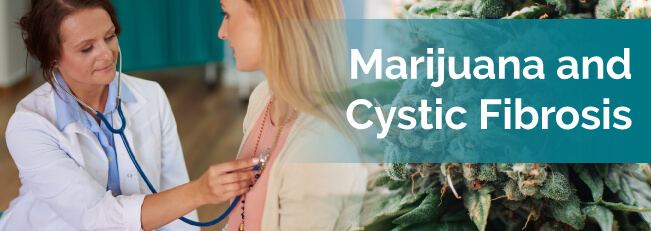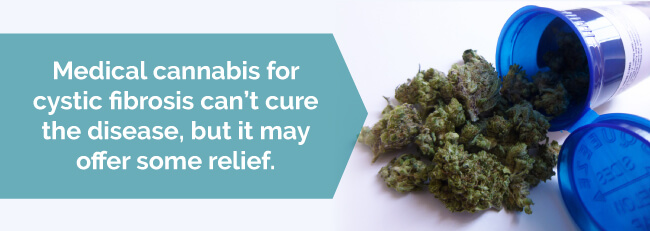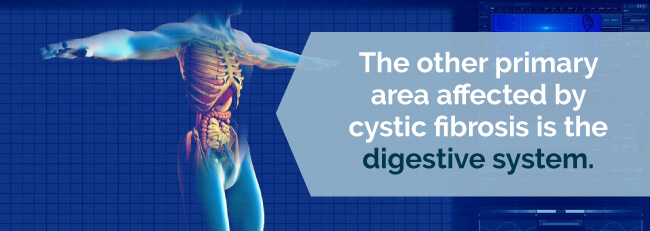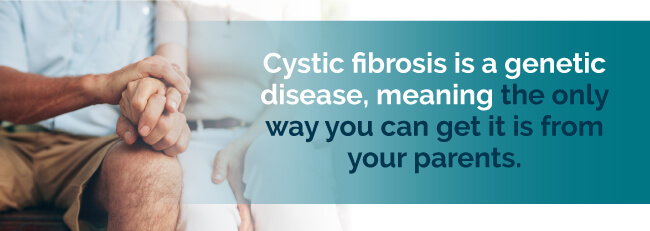
Cystic fibrosis is a life-threatening genetic disease that often shortens the lifespan significantly. It affects approximately 30,000 people in the U.S., with about 1,000 new cases each year. While there is no cure for cystic fibrosis, treating the symptoms can provide comfort and improved quality of life for patients with the condition. Research on the use of medical marijuana for cystic fibrosis is limited, but the natural treatment option shows promise in treating some of the effects of the disease.
Cystic fibrosis is a genetic disease that alters the body’s respiratory, digestive and reproductive systems. It effects the body’s epithelial cells that compromise the body of the lungs, pancreas, liver, sweat glands, digestive tract and reproductive system. Normally, the epithelial cells release a slippery layer of mucus, capture dust and germs and act as a lubricant. A person with cystic fibrosis inherited a gene that causes the epithelial cells to produce a defective protein. That protein leads to the formation of thick, sticky mucus which causes many serious problems. The sticky mucus can clog the bronchial tubes, interfere with breathing, causing coughing and wheezing, cause fatigue and interfere with digestion and absorption of nutrients, which can limit growth and weight gain and cause chronic diarrhea. Common symptoms of cystic fibrosis include persistent coughing, poor weight gain, bulky stools and very salty-tasting skin in infants. Treatment of cystic fibrosis varies according to the stage of the disease and which organs are affected. Learn more below about how medical marijuana can help treat cystic fibrosis.
Medical cannabis for cystic fibrosis can’t cure the disease, but it may offer some relief from symptoms in conjunction with your other treatments and medications.

The cannabinoids in marijuana have a variety of effects on the body, many of which align with the symptoms of cystic fibrosis. While it may not eliminate the symptoms completely, medical cannabis may help lessen the severity of those symptoms.
Certain forms of medical marijuana are known to increase appetite and reduce nausea. This can help with weight loss and loss of appetite. However, it is unlikely to help in the absorption of nutrients, though eating more does increase the chances of a cystic fibrosis patient acquiring nutrients from food.
Aches and pains are sometimes a side effect of the disease, including abdominal and chest pain where the disease has the most impact. Some patients also suffer from kidney stones or gallstones, which also produce pain. Marijuana has a pain-relieving effect that can ease that discomfort.
Another effect of cystic fibrosis in the body is inflammation, particularly in the lungs. Cannabinoids have an anti-inflammatory effect on the body. The lungs also do have cannabinoid receptors, so it is possible that weed could reduce inflammation in the lungs.
Some cystic fibrosis patients deal with frequent diarrhea due to the effects of the disease on the digestive system. Cannabinoids may help reduce diarrhea, which in turn helps prevent nutrient loss. This benefit not only makes the patient feel more comfortable, but it also helps the body get the nourishment it needs.
There is a very limited amount of material regarding medical marijuana and cystic fibrosis. In fact, it seems very few medical scientists have delved into this area of medical marijuana research. That may change with methods of medical marijuana delivery and synthetic derivatives of cannabis being developed more frequently than in the past.
Now, to say that there is a severe lack of research in this area is not to say there is none. A doctor by the name of Ester Fride did delve into the many possibilities for medical marijuana as cystic fibrosis medication in her paper “Cannabinoids and Cystic Fibrosis: A Novel Approach to Etiology and Therapy.” Not only were the above proven qualities of the drug discussed, but she also went on to suggest that medical marijuana could assist in bronchodilation and act as an anti-inflammatory.
In 1998, Raphael Mechoulam conducted a study on the effects of THC on nausea and vomiting in patients receiving chemotherapy. While the study was not directly related to cystic fibrosis, vomiting does often affect cystic fibrosis patients, contributing to loss of appetite, which can lead to the malnutrition common in the disease. Marijuana could improve the patient’s nausea and vomiting, potentially improving appetite in people suffering from cystic fibrosis.
The objection to children using medical marijuana appears to be the “high” produced by recreational marijuana. Not all medical marijuana produces this effect. One example of medical marijuana that does not produce this high is JWH133. The potential for this medication and others to help individuals with cystic fibrosis has not been established. However, there is hope for future research in the area. Nevertheless, despite the lack of research in some areas of cystic fibrosis and medical marijuana, there is sufficient research on medical marijuana for other diseases to support its use for cystic fibrosis sufferers.
THC is the cannabinoid often associated with relief from cystic fibrosis symptoms. Different strains of marijuana have varying levels of THC and other cannabinoids. For example, some are very low in THC while being high in CBD. Others have a more balanced profile or a higher level of THC.
An experienced marijuana doctor can help you find a suitable strain of marijuana that matches your symptoms and your desired effects. Some of the strains that may be beneficial for cystic fibrosis include:
How you take marijuana for cystic fibrosis is an important decision. Smoking is a common option for taking marijuana with almost instant results, but it is not the best option for patients suffering from cystic fibrosis. Smoking can cause irritation to the lungs. Because cystic fibrosis can cause potentially fatal lung complications, it is not a good idea to damage the lungs further by inhaling smoke. However, there are a number of different ways to ingest medical marijuana, so it is safe for cystic fibrosis sufferers in other forms.
One of those options is vaporizing the weed. In this method, the vaporizer heats up the air around the marijuana to turn it to vapor rather than using combustion like smoking. The lower heating point reduces byproducts created during the process, and it is easier on the lungs. Vaporizing has an almost instant effect on the body, which is a plus for people who want fast relief.
If you don’t like the idea of inhaling the marijuana, edibles may be a suitable alternative. Marijuana-infused edibles come in almost any type of food, including snacks, baked goods and even beverages. Some people prefer the idea of simply eating or drinking something to ingest the marijuana. The effects don’t kick in for anywhere from 30 minutes to a few hours, but you’ll feel the effects for much longer than you would by smoking or inhaling the cannabis.

Another option is a topical application through the use of lotions, salves, balms or oils. Tinctures are also an option and can be applied under the tongue for fast absorption into your system.
You can use a combination of ingestion methods to create a system that works best for relieving your symptoms. Some people find certain ingestion methods or strains of marijuana ideal for certain parts of the day, while others are better suited for other times. For example, you might use an edible infused with an indica strain an hour or two before bed, so the effects last through the night. In the morning, you might prefer vaporizing an energizing sativa strain for fast results that won’t leave you sleepy.
Marijuana has very few side effects, and they are generally considered to be mild. Many times those side effects can actually be beneficial to patients with cystic fibrosis. Still, it’s important to know what to expect if you choose to treat your symptoms with cannabis.
One of the most notable side effects is a feeling of euphoria or a “high” feeling, particularly with strains high in THC, which is thought to help cystic fibrosis. While some people might not mind this sensation, it may be a problem if you need to drive or maintain a clear mind for work-related tasks.
Another potential side effect is appetite stimulation. In the case of cystic fibrosis, this can be a major benefit since many patients have appetite and nutritional issues.
Marijuana can leave you feeling drowsy, particularly if you choose an indica strain. At nighttime, this can be a bonus, as it may help you sleep better. During the day, however, the drowsiness can interfere with your routine. Using a sativa strain during the day can provide you with the benefits of marijuana with less of a sleepy effect. Sativa tends to have an energizing effect on the body.
Medical cannabis is an affordable alternative treatment option that may help relieve some cystic fibrosis symptoms. If you or a loved one suffers from cystic fibrosis, and you want to explore the possibility of using medical marijuana as part of your treatment plan, we can help. With hundreds of marijuana doctors in all legal marijuana states, we can help you find one near you.
For more information about how cannabis can be used to treat Cystic Fibrosis, check out our resources:
Find A Doctor Find A Dispensary
Cystic fibrosis is a genetic disorder that affects secretions of the body, particularly causing problems in the lungs and digestive system, although it can affect other organs. The primary effect of the condition is a production of mucus, sweat and digestive juices that are thicker than normal. In a person without cystic fibrosis, those secretions are slippery and thin, creating a lubricant-like effect in the body. With cystic fibrosis, a defective gene causes the secretions to become thicker and stickier than normal. Therefore, the secretions create blockages in ducts, passageways and tubes inside the body, rather than providing lubrication. The mucus causes potentially fatal problems in the respiratory and digestive systems, with the lungs and the pancreas often being affected the most.
Cystic fibrosis can cause symptoms as early as birth. Newborns with cystic fibrosis may not have a bowel movement for the first two days of life. Growth may occur later than expected in children, and they may fail to gain appropriate weight for their age. Over the course of the disease, the symptoms may fluctuate between severe and easily manageable. The effect of the disease differs significantly from one person to the next. The most obvious effects of cystic fibrosis are respiratory symptoms. The abnormally thick mucus lines that tubes that bring the air in and out of the lungs, causing problems with lung function.
Some of the effects on the respiratory system include:

The other primary area affected by cystic fibrosis is the digestive system. Weight loss or failure to gain weight is related to the digestive symptoms of cystic fibrosis. The thick mucus inhibits the movement of digestive enzymes from the pancreas to the small intestine by blocking the tube, which makes it difficult for the body to absorb nutrients from food. The food is essentially digested without nourishing the body.
Other digestive symptoms include:
The body will also secrete increased amounts of salt, leading to salty sweat. Parents may notice the saltiness when they kiss their kids, as the excess makes the skin taste very salty.
The disease can lead to some serious complications depending on the severity of the symptoms. Over time, the condition can cause damage to the body, primarily in the lungs and the digestive system. Some of those complications include:
Cystic fibrosis can also cause infertility issues. About 97 percent of men with the condition are infertile, although they are not sterile. In other words, the sperm is there, but they are stuck in the testes. This is sometimes due to the lack of a vas deferens, the tube that carries the sperm to the ejaculatory ducts in the penis. In other men, the tube is there, but cystic fibrosis causes a blockage, preventing sperm from passing through the tube. When sperm production is normal, assisted reproductive technology can help men with cystic fibrosis have biological children.
Women with the condition may have fertility issues, but many can successfully have children. Cystic fibrosis causes the cervical mucus to thicken, which sometimes makes it more difficult for the sperm to pass through the cervix. Another factor is ovulation irregularity due to poor nutrition. During pregnancy, women sometimes experience more severe cystic fibrosis symptoms.

Cystic fibrosis is a genetic disease, meaning the only way you can get it is from your parents. It happens due to a defect in the gene, but it isn’t just one defect. The defect can be caused by over 1,700 possible mutations, which can make screening more difficult since genetic testing only looks for the most common mutations. This means someone could be a carrier without the screening revealing that.
Some people are carriers of the defective gene without actually having the disease. Approximately 10 million Americans are carriers of the mutated gene. For a child to have cystic fibrosis, both parents must have the defective gene. However, even if both parents have the defective gene, it isn’t certain that the child will have it. The child of two carriers has a 25 percent chance of developing the disease, a 50 percent chance of being a carrier without developing the disease and a 25 percent chance of neither.
Cystic fibrosis affects your lifestyle because it requires daily care. While still disruptive, the quality of life now for patients with cystic fibrosis is significantly better than in the past. Life expectancy has also increased due to better screening and treatments for the condition. On average, many patients live to their mid to late 30s. Some live longer, reaching their 40s or 50s.
Currently, there is no cure for cystic fibrosis. Physicians treat the symptoms of the disease on a case-by-case basis because the effects are often so different from one person to the next. The goal of treatment is to relieve the symptoms themselves and to reduce any complications that happen due to the disease. In particular, doctors aim to prevent and treat infections and intestinal blockages and loosen and remove mucus in the lungs. Ensuring proper nutrition is also a key component in the treatment plan.
Cystic fibrosis is a very complex and serious health condition, so it’s important to work closely with health care providers for your primary treatment. The care team often includes several different specialists with experience in cystic fibrosis to closely monitor your condition and make adjustments to the treatment as needed.
A number of drugs are used to treat the symptoms of cystic fibrosis, including:
The treatment routine often includes various therapy and rehab. One option is chest physical therapy. This type of therapy often takes place multiple times a day with the goal of loosening the mucus in the lungs. The loosened mucus is much easier to cough up. Clapping cupped hands on the chest, both front and back, is a common method. Another option is a vibrating vest or a breathing tube and mask to loosen the mucus.
Other possible therapy, surgery and treatment options include: